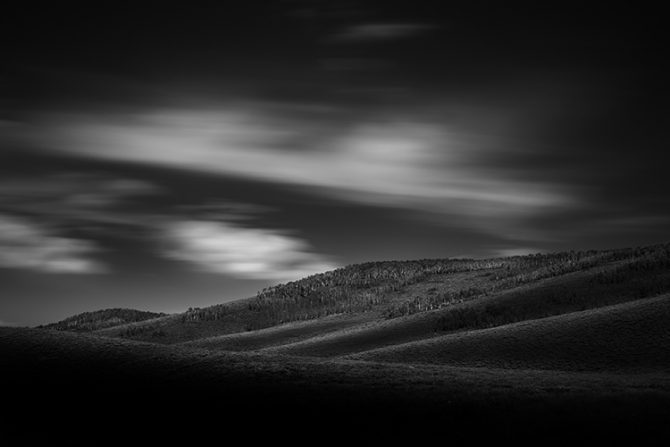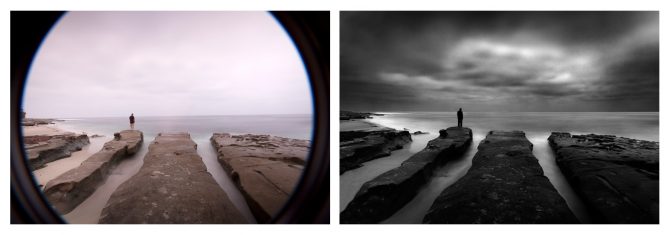September 18, 2014
Five + Ten + Fifteen + Twenty + Vari-ND = Perfect ND Kit
 Utah Hills, Created with the Singh-Ray 15 Stop Fixed ND Filter
Utah Hills, Created with the Singh-Ray 15 Stop Fixed ND FilterAfter years of experimentation and trying various ND filter combinations, I have assembled what I believe to be the worlds perfect ND kit. It consists of the following:
5 stop fixed ND filter in 82mm
10 stop fixed ND filter in 82mm
15 stop fixed ND filter in 82mm
20 stop fixed ND filter in 82mm
Singh-Ray Vari-ND in 82mm
Step up rings on each of my lenses so they all can use 82mm filters
Those of you who are shooting long daytime exposures will appreciate what this means. I can now shoot with 5, 10, 15 or 20 stops of ND without stacking two filters together or vignetting!
I am in pig heaven. Seriously.
But my perfect kit would not be complete without a Singh-Ray Vari-ND filter. This is a variable filter that gives you between 3 and 8 stops of neutral density and it works just like a polarizer: turning it one way gives you more ND and turning it the other way gives you less.
It is critically important for me to have this variable filter because it allows me to photograph dynamic subjects (eg: people or other moving objects) quickly without removing the filter to compose the image.
With fixed filters the viewfinder is so dark that I cannot compose without removing the filter. And taking filters on and off takes precious time (which I may not have when photographing people) and sometimes I accidently change the zoom or focus settings, which ruins the shot.
With the Vari-ND I can dial the filter open, compose, and then close the filter down to shoot. I can do this very quickly which is critical.
The Vari-ND filter is the one piece of equipment that allowed me to photograph the ghosts at Auschwitz-Birkenau.

If had I visited the camps armed only with my fixed ND filters, I could not have created these images.
Now some of you looking at this list of filters might be thinking: everyone has heard of a 5 and 10 stop…but a 15 and 20???
Yes! Singh-Ray offers a 5, 10 and 15 stop filter and then they built a 20 stop filter for me (which I think they’ll be offering to the public before long).
Why would I want a 20 stop filter? Because it allows me to get an 8 and 16 minute exposure in bright daylight, and now I don’t have to stack to get it! Stacking creates some serious vignetting when shooting wide, here’s a before-and-after of a two stacked filter shot to illustrate:

Being able to go from 5 to 20 stops without stacking is a huge deal for me.
I hope this doesn’t sound like a commercial for Singh-Ray because it’s not, but it is an honest plug. I’ve long depended on Singh-Ray’s filters, they are top quality and the customer service is unbeatable.
So if you’re wondering what ND filters to buy, here is the perfect combination of filters to aspire to.
Cole
P.S. Just to balance out all this technical talk, here is a favorite story of mine that puts equipment into perspective:
“A photographer went to a socialite party in New York. As he entered the front door, the host said ‘I love your pictures – they’re wonderful; you must have a fantastic camera.’ He said nothing until dinner was finished, then: ‘That was a wonderful dinner; you must have a terrific Stove.’” Sam Haskins
Cole as usual you are so gracious in sharing your thoughts and recipes. Your explanations will save many much frustration and money.
Have you tested the new Nikon 750? Supposedly has a 3EV focusing rating. Or does that even matter?
Please convince Singh-Ray to produce the 20!
Thanks for the tips!
Congrats Cole, the 20 stops ND filter is really something!
Have had the Vari-ND for a while, and experienced some “banding” in the image, when filter is set to the darkest end.
Is that a function of the focal length of the lens?
Thanks for the info on ND’s.
Thanks for the inspiration, Cole. This makes me want to change direction and just experiment with this filter and long exposures.
Thanks for sharing this information, Cole. Now I want a variable ND! I did wonder how you got your shots of people……
Hi Cole ~ quite a serendipitous post. I was at the river today, using my Vari-ND and a 3-stop ND, and the best I could do was 25 seconds. So on the way home I was thinking that perhaps it’s time to get a 10- or 15-stop ND. And perhaps soon a 20-stop? Woo hoo!
Here is a rough guide to know how much ND you need in bright sunlight, at ISO 50 and f22:
5 stops of ND 1/8 second
10 stops of ND 4 seconds
13 stops of ND 30 seconds
15 stops of ND 2 minutes
If your camera will only go to ISO 100, then you’ll need another stop of ND to reach these times. And if your camera will stop down smaller than f22, then you’ll need less ND.
A Vari-ND with a 5 stop ND filter is where I started.
But if you need to economize and can only buy one filter, I’d start with a 15 stop ND filter. It’s not as convenient as the Vari-ND but it will get you a 2 minute exposures and since you’ll not be stacking, you can shoot wide angle with it.
Cole,
It looks like many of the manufactures are coming out with big light reducing ND filters. I just bought the Firecrest 16 Stops ND Filters (IRND 4.8) by Formatt-Hitech which just hit the market. I was looking for more light reduction without stacking filters and jumped on buying this one when I saw it released. Singh-Ray as well as B&W are great products. I haven’t tested this filter yet but have read some good reviews. I will be heading to the West coast next week and will see how it works. Hopefully it will meet my expectations.
Hi Cole,
Thank you for posting your experiences using ND filters. Some very helpful information that would shortcut my learning if I did more long exposure work. I am very fond of your Auschwitz-Birkenau series, not only great images, but also a compelling and poignant narrative.
John
http://johnmenneer.co.nz/
I just skimmed this article because I was checking out your other article on Vision which is really awesome, btw, and I don’t use filters much if at all.
But I did get to the end of this filter article and that last bit in the PS is too true and too funny.
Sometimes people focus on the things which are technical, tangible, and measurable… do I have the right equipment, have I read the right manual, and do I have the right ingredients to make this work?
But they forget that it’s the heart, the soul and the mind which bring everything together and make the work SING.
Also, I enjoyed the article on Vision and your comment:
I committed that from that point on, I would only pursue those kinds of images, the ones that I really loved. Too often I had been sidetracked when I chose to pursue images simply because others liked them.
That’s truth!
I just stumbled upon your blog today and plan to keep it on my radar from now on.
Best,
Carlin
This is a great info Cole. One question, I have experience the dreaded ‘X’ pattern when using a variable ND filter, although not the quality of the Singh-Ray. Do you experience this with the Singh-Ray Variable ND filters?
Thanks
Bob, all variables filters can get the dreaded X pattern under certain conditions. But what I cannot tell you is if a cheap filter has more of a problem with it than a quality filter like Singh-Ray.
I rarely have a problem with my Singh-Ray by keeping away from the wide angles on my zooms.